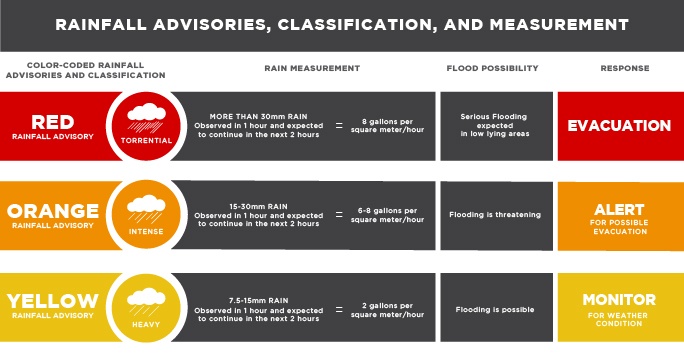
With around nine typhoons making landfall on its shores each year and that many more crossing its waters, the Philippines is among the countries most exposed to storms in the world. While experience and infrastructure have come some way in mitigating the effects of such storms, the strongest ones can still cause significant damage, and even moderate ones can disrupt routines.
Businesses that outsource projects or processes to the Philippines might reasonably see this as cause for concern. Given the long history of such problems, however, most Philippine companies are equipped with strategies and facilities to cope with such situations and remain functional in all but the worst of storms. Foreign businesses looking to offshore can easily prepare contingencies—and allay any remaining fears—with some understanding, foresight and preparation.
Two Seasons
The Philippines has two main seasons, characterized mainly by the amount of rainfall experienced during each one. The dry season runs generally from November to April, while the rainy season persists from May to October. Seasons are not always particularly distinct, however, and many parts of the country experience rainfall all year round.
Storms usually enter the country around June and increase in frequency over the course of a few months. Frequency peaks in August and drops as the rainy seasons draws to a close. Nonetheless, many of the country’s deadliest and most destructive storms made landfall late in their respective seasons, in the range of September to November.
To deal with the frequency of such storms, the Philippine Atmospheric Geophysical and Astronomical Services Administration (PAGASA) uses a system of tropical cyclone warning signals—commonly shortened to ‘storm signals’—to inform the public of approaching storms and allow them to take appropriate measures. PAGASA also issues rainfall warnings in cases where even without a cyclone, extreme precipitation puts a community at risk.
-
TCWS #1 - Tropical cyclone winds of 30 km/h (19 mph) to 60 km/h (37 mph) are expected within the next 36 hours.*
-
TCWS #2 - Tropical cyclone winds of 61 km/h (38 mph) to 120 km/h (75 mph) are expected within the next 24 hours.
-
TCWS #3 - Tropical cyclone winds of 121 km/h (75 mph) to 170 km/h (110 mph) are expected within the next 18 hours.
-
TCWS #4 - Tropical cyclone winds of 171 km/h (106 mph) to 220 km/h (140 mph) are expected within 12 hours.
-
TCWS #5 - Tropical cyclone winds greater than 220 km/h (140 mph) are expected within 12 hours.

* If a tropical cyclone forms very close to the area, then a shorter lead time is seen on the warning bulletin.
Contingency Plans
Dealing with rain is a way of life in the Philippines. Residents learn, as early as elementary school, to anticipate advisories for suspensions of classes when storms arrive. Companies, meanwhile, often take similar measures if typhoons are predicted to reach their worst, but use a variety of other solutions to cope with less imposing storms.
Storms affect working conditions usually in the following ways: interference in movement and transportation, caused by heavy rain and flooding; disruption of communication and/or power, due to broken lines and collapsed towers; and, of course, damage to property and facilities from extreme winds or rainfall. A prudent contingency plan addresses all such possibilities.
When commuting to work would be difficult, for instance, employees might be urged to work from home or other suitable and safe places nearby. Work is coordinated online or over the phone. Conversely, if residential areas lose power or communication lines amid intense weather, it is not unheard of for offices to allow workers to take shelter on grounds until conditions stabilize.
One of the more comprehensive solutions is a disaster recovery site or alternative site, where operations can continue if a company’s main site is damaged or inaccessible. Sometimes, such sites provide an alternative workspace for employees who find it easier to reach than the company’s main facility. Either way, such sites ensure access to critical data and equipment even under dire circumstances.
Bringing all such measures together are the overall disaster-response or continuity systems that companies put in place. These provide guidance on when to diverge from routine, how decisions are to be made, and how lines of communication and command might change; they provide directions, in other words, of when any more specific measures should be utilized. Furthermore, the best of such strategies are regularly put to the test through drills or predictive models.
Weathering Offshore Storms
A good business process or creative outsourcing agency will have its own protocols in place, but weathering the storm requires that procedures allow operations to carry on smoothly both on their shores and yours. When weather is your concern, be sure to ask any prospective outsourcing agencies about their continuity plans and disaster-recovery preparations. If they can provide you with comprehensive responses, you can count your projects well taken care of. That said, their preparations shouldn’t be considered the end of the line—take time to establish or affirm points of contact under such circumstances and, if your work goes through the worst of the storm season, take the opportunity to flesh out a timetable that will account for potential disruptions.
For more information on preparing and fine-tuning outsourced solutions for your company, check out our eBook on creative process outsourcing.




Comments